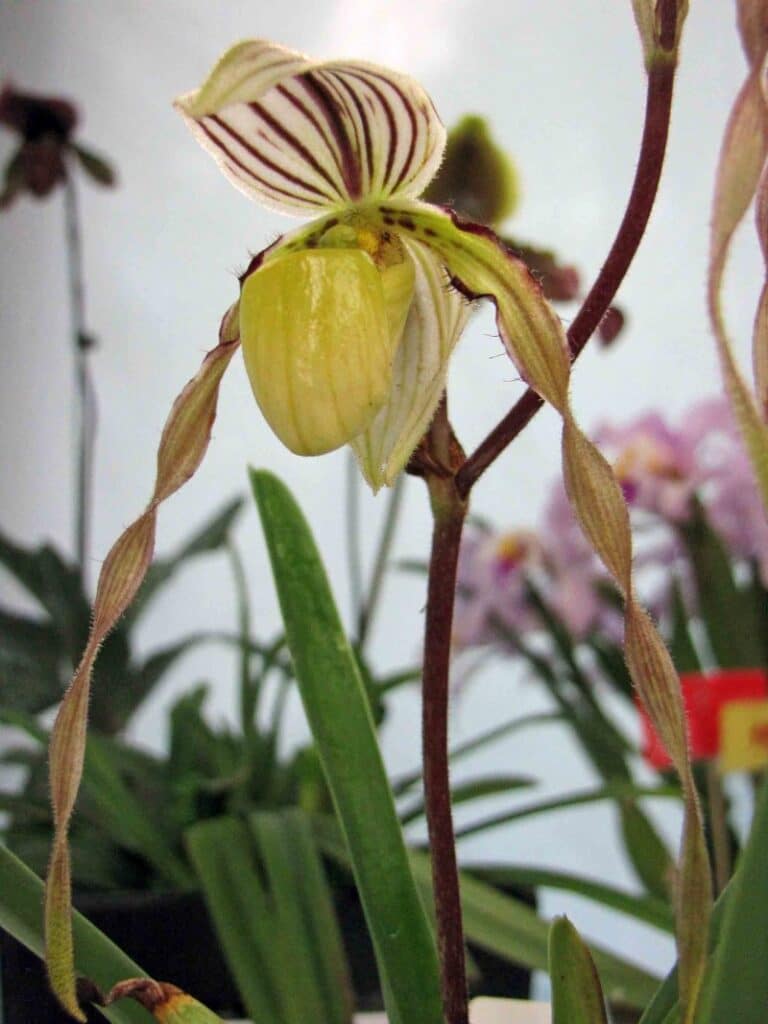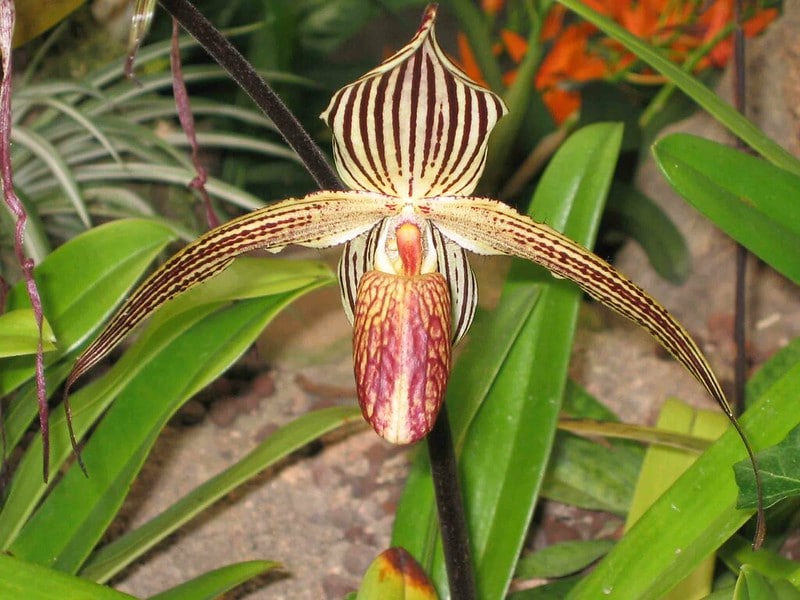Paphiopedilums, otherwise known as lady slippers orchids or Venus’ Slipper orchids, are ornamental plants that you can easily recognize even from afar. Of all orchid types, they have the most prominent pouch-like lip that resembles a slipper, hence the name.
Like other popular orchids, such as the moth orchids, cattleyas, and dendrobiums, these gardener-favorites come in a myriad of flower colors, including yellow, pink, red, brown, and green. Here are some useful facts about paphiopedilum orchids and a guide on how to grow them.
Facts About Paphiopedilum Orchids
Lady slippers orchids are native to the Philippines and other parts of Southeast Asia. They can also be found in Northern India and Southern China. The majority of plants in this genus are semi-terrestrial, but some species are terrestrial or epiphytes (1).
The genus name Paphiopedilum comes from the Greek word pedilon, which means “slipper,” referring to the flower’s notable slipper-like labellum or lip (1).
Plant Description
Orchids from the Paphiopedilum genus are long-bloomers. They flaunt attractive flowers that last for more than six to eight weeks from autumn to spring. Most paphs produce one flower per spike, but some species showcase multiple blooms on a single stem. The flower characteristics, sizes, and colors greatly vary depending on the species.
The leaves of lady slipper orchids can either be solid green or mottled depending on the species. Generally, solid green-leaved paphiopedilum orchids are cool growers, while mottled-leaved types are warm growers.
Popular Paphiopedilum Orchids Species
Paphiopedilum barbigerum

Common name: The Beard Carrying Paphiopedilum
Paphiopedilum philippinense

Common name: Philippine Paphiopedilum
Paphiopedilum rothschildianum

Common names: Gold of Kinabalu Orchid, Rothschild’s Slipper Orchid
Paphiopedilum fowliei
Common name: Fowlie’s Paphiopedilum
Paphiopedilum ciliolare
Common name: Short Haired Paphiopedilum
Paphiopedilum acmodontum
Common Name: Pointed Tooth Paphiopedilum
Growing Venus Slippers Orchids
Are you interested in growing lady slipper orchids but not sure how to start? Many gardening beginners get a little anxious about growing orchids mainly because they think that these plants are difficult to care for and grow when, in fact, it is a common misconception.
The lady slipper orchids are among the easiest types of orchids to grow. By simply following the basic principle of culture, these plants will reward you with one of the most beautiful blooms that you could grow from the comfort of your home. Continue reading below for some valuable tips on how to grow paphiopedilum orchids.
Light
Paphiopedilums are low-light orchids that do not need as much light as vandas, cymbidiums, and cattleyas. Exposing them to too much direct light may result in reddish tinge on the leaf edges, whereas underexposure may cause difficulty in reblooming and pale leaves.
When grown as houseplants, an east window is best. However, the west window or south window can still be utilized if shaded with a sheer curtain.
Temperature and Humidity
Generally, provide lady slippers orchids with night temperatures of 50 to 60°F and daytime temperatures of less than 80°F. However, while both variations can co-exist within the same temperature range, The Maudiae type plants with mottled leaves thrive better in the warmer end, while their green-leaved counterparts prefer slightly cooler nights.
As for the humidity requirements, these orchids require high humidity levels of 50-60% humidity.
If your place is not humid enough, you can place the orchid pot in a tray of pebbles with water on the bottom. However, make sure that the roots are not submerged into the water or else rotting may likely occur.
Air movement is critical, especially when humidity levels are high.
Water
One distinct feature of plants in the Paphiopedilum genus is that they do not have pseudobulbs, a plant part that gives them the capability of storing water. Hence, these plants require a moist but not soggy growing medium and should not be allowed to dry out.
Watering should be made every 5 to 7 days, or at least twice a week, with enough water to ensure that the potting medium is thoroughly moistened. Do this by placing the plant in the sink, allowing lukewarm water to run through the pot for about a minute. Drain the plant entirely to avoid root rot.
Fertilizer
Feeding your paphiopedilum orchids at least once a week with a quarter strength balanced fertilizer (20-20-20) after watering should be sufficient enough. Flush the pot with distilled water once a month to remove salt accumulation from fertilization.
Growing Media and Pots
The key to successfully growing a lady slipper orchid plant is to keep a good root system, and you can only do this if you provide it with the right potting medium.
The potting media should not be allowed to dry out, especially since these plants have no pseudobulbs for water storage. To avoid this, choose a mix with good drainage and moisture retention, such as a Cypress or Fir Bark-based option with a small amount of fine particulates to hold more water.
Ideally, paphiopedilum orchids should be repotted once a year or when the plant has outgrown its current pot. Plastic pots retain moisture better compared to clay pots.
Common Pests & Plant Diseases
Paphiopedilum orchids can occasionally face issues such as aphids, scale insects, or fungal infections. Regular inspection of the leaves, roots, and surrounding medium, coupled with proper orchid care practices, can help prevent and manage these potential problems.
FAQs
How often do Paphiopedilum orchids bloom?
Paphiopedilum orchids, commonly known as Lady’s Slipper orchids, typically bloom once a year. The exact timing can vary based on the specific Paphiopedilum species or hybrid and the growing conditions.
How do I get my Paph to bloom?
To encourage Paphiopedilum orchids to bloom, provide them with the right growing conditions. This includes a well-draining orchid mix, indirect light, consistent moisture, and a slight temperature drop during the night. Additionally, ensure the orchid is mature enough, as some Paphiopedilum varieties may not bloom until they reach a certain age.
What is the best fertilizer for Paphiopedilum orchids?
Paphiopedilum orchids benefit from a balanced and diluted orchid fertilizer, such as a 20-20-20 or 10-10-10 formula. Fertilize them regularly during the growing season (spring and summer) and reduce or stop fertilization during the dormant period (fall and winter).
How long do Paphiopedilum blooms last?
Paphiopedilum blooms can last anywhere from a few weeks to a few months, depending on the specific variety and environmental conditions. Once the flowers begin to fade, you can cut the flower stem (spike) at its base, and the plant will redirect its energy to new growth and potential future blooms.
Final thoughts
In conclusion, the paphiopedilum orchids care demands a thoughtful balance of attention to detail and a deep understanding of their unique needs. Successfully cultivating these captivating slipper orchids involves creating a suitable environment, properly watering and light conditions, and vigilantly monitoring potential pests and diseases.
By incorporating these essential care practices, orchid enthusiasts can enjoy the graceful beauty of Paphiopedilum orchids while fostering their health and longevity in a home or greenhouse setting. These orchids are also easy to grow and make a great addition to any plant collection.
References
Reference List
- Ndsu.edu. (2020). Paphiopedilum barbigerum – Val. [online] Available at: https://www.ndsu.edu/pubweb/chiwonlee/plsc211/student%20papers/articles03/val.eitreim/veitreim.htm
- Teoh, E., 2009. Orchids Of Asia. Singapore: Marshall Cavendish Editions.
- Ent, Antony & van Vugt, Rogier & Wellinga, Simon. (2015). Ecology of Paphiopedilum rothschildianum at the type locality in Kinabalu Park (Sabah, Malaysia). Biodiversity and Conservation. 24. 10.1007/s10531-015-0881-0.
Close
*Photo by stockphototrends/depositphotos







